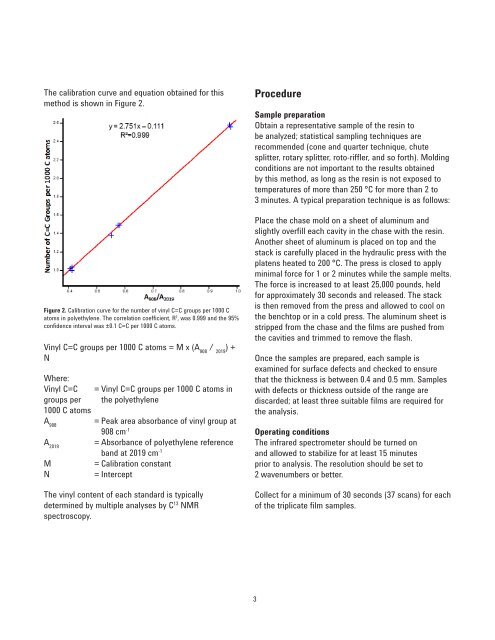Application Compendium - Agilent Technologies
Application Compendium - Agilent Technologies
Application Compendium - Agilent Technologies
Create successful ePaper yourself
Turn your PDF publications into a flip-book with our unique Google optimized e-Paper software.
The calibration curve and equation obtained for this<br />
method is shown in Figure 2.<br />
Figure 2. Calibration curve for the number of vinyl C=C groups per 1000 C<br />
atoms in polyethylene. The correlation coefficient, R 2 , was 0.999 and the 95%<br />
confidence interval was ±0.1 C=C per 1000 C atoms.<br />
Vinyl C=C groups per 1000 C atoms = M x (A 908 / 2019 ) +<br />
N<br />
Where:<br />
Vinyl C=C = Vinyl C=C groups per 1000 C atoms in<br />
groups per the polyethylene<br />
1000 C atoms<br />
A = Peak area absorbance of vinyl group at<br />
908<br />
908 cm-1 A 2019<br />
= Absorbance of polyethylene reference<br />
band at 2019 cm -1<br />
M = Calibration constant<br />
N = Intercept<br />
The vinyl content of each standard is typically<br />
determined by multiple analyses by C 13 NMR<br />
spectroscopy.<br />
Procedure<br />
Sample preparation<br />
Obtain a representative sample of the resin to<br />
be analyzed; statistical sampling techniques are<br />
recommended (cone and quarter technique, chute<br />
splitter, rotary splitter, roto-riffler, and so forth). Molding<br />
conditions are not important to the results obtained<br />
by this method, as long as the resin is not exposed to<br />
temperatures of more than 250 °C for more than 2 to<br />
3 minutes. A typical preparation technique is as follows:<br />
Place the chase mold on a sheet of aluminum and<br />
slightly overfill each cavity in the chase with the resin.<br />
Another sheet of aluminum is placed on top and the<br />
stack is carefully placed in the hydraulic press with the<br />
platens heated to 200 °C. The press is closed to apply<br />
minimal force for 1 or 2 minutes while the sample melts.<br />
The force is increased to at least 25,000 pounds, held<br />
for approximately 30 seconds and released. The stack<br />
is then removed from the press and allowed to cool on<br />
the benchtop or in a cold press. The aluminum sheet is<br />
stripped from the chase and the films are pushed from<br />
the cavities and trimmed to remove the flash.<br />
Once the samples are prepared, each sample is<br />
examined for surface defects and checked to ensure<br />
that the thickness is between 0.4 and 0.5 mm. Samples<br />
with defects or thickness outside of the range are<br />
discarded; at least three suitable films are required for<br />
the analysis.<br />
Operating conditions<br />
The infrared spectrometer should be turned on<br />
and allowed to stabilize for at least 15 minutes<br />
prior to analysis. The resolution should be set to<br />
2 wavenumbers or better.<br />
Collect for a minimum of 30 seconds (37 scans) for each<br />
of the triplicate film samples.<br />
3

















